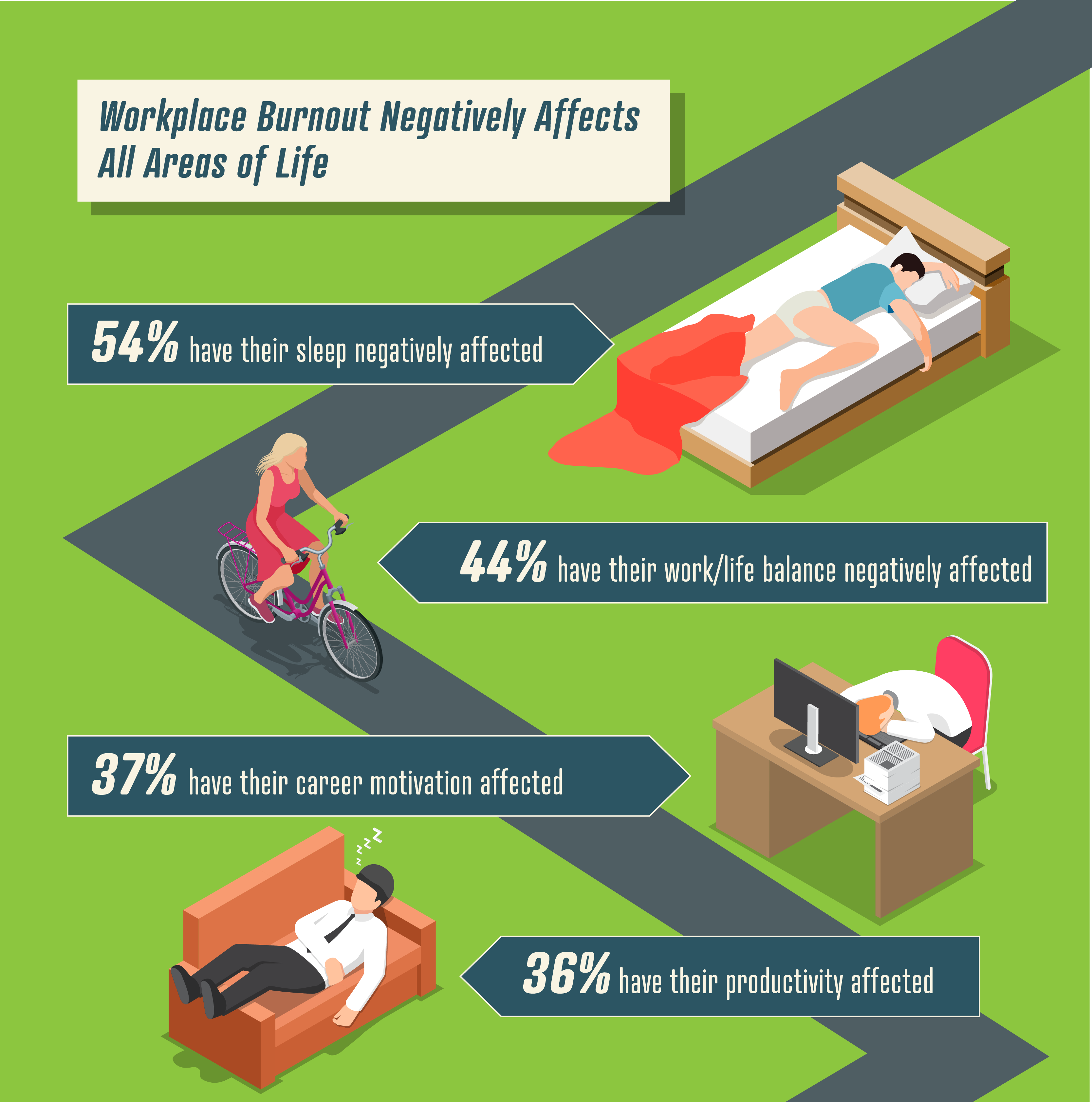Work can be an intense place. From pulling together as a team to complete a big order to setting up virtual numbers in new markets, the fast-paced, chaotic, and often trying workplace can lead us to tear our hair out.
Thankfully, awareness of how this can affect our mental and physical health is growing. As of this year, “Burnout” was officially recognized as an illness by the World Health Organization.
The illness is defined as the following by the WHO:
- Feelings of energy depletion or exhaustion
- Increased mental distance from one’s job, or feelings of negativism or cynicism related to one’s job
- Reduced professional efficacy
Now the symptoms are being given serious thought, how many of us are experiencing the symptoms of burnout at work? We surveyed 2,000 Americans on their workplace experiences of burnout with the aim of helping businesses address the issue.
Burnout affects us all
Asked if they consider themselves suffering from common symptoms of burnout, over a third (36%) of US employees surveyed said they do every week; 56% said it occurs monthly. Just 12% of the workforce said they have never experienced burnout in their current role.

Delve into the specific symptoms and we find the true extent of common causes of burnout. In most cases, it’s appears to be stress. Over half (56%) said they suffer from stress at work every week, with just 6% saying they never experience it. Elsewhere, these other burnout-related symptoms occur every week:
- Frustration – 52%
- Fatigue – 52%
- Anxiety – 40%
- Disengagement – 29%
It all adds up to employee exhaustion, which affects 44% of the US workforce every week.
The intensity of some offices is causing a large proportion of the workforce to struggle with the pressures of not only working life, but home life too. Over half (54%) of respondents said that burnout had negatively affected their sleep, while 44% said the same for work/life balance. Employees are all too aware of the damage it may be causing them too. 67% said they were worried about what the effects of burnout might be having on them long-term.
For those business owners that have little time for their employees, you’re actually reducing your chances of long-term success.
It costs businesses talent and money
Alongside the home, health, and social-based effects of burnout, the stresses of the workplace can have a crippling effect on quality of work. 36% of respondents said burnout had affected their productivity, while 29% said the quality of their work had been affected. The drive to push yourself also takes a downturn. 37% said their career motivation had taken a hit due to burnout.

It all results in people looking elsewhere. 55% of employees said they have considered leaving their current employment due to a lack of support for the symptoms of burnout. It may be hard to link directly to the balance street, but less productive staff, mixed with higher staff turnover, costs every company revenue.
A secondary cost to businesses is sick days. Symptoms of burnout leave us feeling run down, lethargic and susceptible to illness. As a result, nearly a quarter of workers (23%) said they take a sick day off work at least every two months due to burnout.
The stats show a significant problem for businesses of all sizes, but not enough is being done. Half of employees said their organization wasn’t offering the support they need to deal with the effects of burnout. 37% said their organization offers no support for burnout at all.
We then asked respondents what it is they’d like to see at work to help ease the burden of burnout. See “Quick tips for dealing with employee burnout” for the most popular responses.
Generation Z are struggling to adapt
Our survey also revealed that the younger you are, the more likely you are to struggle with the damaging effects of burnout. More of Generation Z (aged between 18-24) said they suffer from burnout every week than any other generation. At 46%, Generation Z’s response was higher than Millennials (44%), Generation X (38%), and Baby Boomers (22%).

It’s the same story when you break down each of the common burnout symptoms:
Generation | Exhaustion | Stress | Anxiety |
Generation Z (18-24) | 61% | 66% | 51% |
Millennials (25-34) | 55% | 65% | 50% |
Generation X (35-54) | 43% | 55% | 35% |
Baby Boomers (55+) | 31% | 45% | 27% |
Across all other areas of our survey, Generation Z came in with a higher rate. This is something all businesses that plan to hire from this age group should consider. Key examples include:
- 62% said their sleep is negatively affected by burnout – 8% higher than the overall average.
- 25% take sick days off work at least every month due to burnout – 11% higher than the overall average.
- 76% are concerned about the long-term effects of burnout – 8% higher than the overall average.
As new generations pass through the workplace, so too do new attitudes and demands. Millennials and Generation Z are driving an evolution in the workplace. As the effects of stress and anxiety become more apparent, the onus builds on businesses to do something about it. Those that don’t risk losing the brightest and best young talent that could mold your company for years. As the stats prove; 64% of Generation Z say they’ve considered leaving their current role due to a lack of support over burnout – 9% higher than the overall average.
To solve it, you’ll need to look at your company culture. 52% of Generation Z (again the highest of all generations) said that they’d like their employer to adopt a “culture that supports work/life balance” in order to combat burnout. Other popular suggestions included a “flexible working environment” (47%) and even “mindfulness techniques” (26%).
Healthcare workers feel it hardest
The nature of some industries makes them more intense than others. This leads to an increase in the likelihood that their staff will suffer from symptoms of burnout – as the data suggests. For the healthcare industry, rates of weekly burnout (and the individual symptoms) were higher than the overall averages.
Industry | Burnout | Exhaustion | Stress | Anxiety |
Healthcare | 41% | 52% | 64% | 50% |
Our survey confirmed the high-pressure working environment that many consider healthcare to have. It leads to 65% of people in the industry to consider their position. Given that as recently as April 2019, concerns were raised over a shortage of workers in the industry, it’s even more vital businesses take steps to retain their current workforce.
Tips to limit the symptoms of employee burnout
Office burnout is a real concern, and something that younger generations are becoming more attuned with. To retain the best staff and keep them motivated and productive, businesses must take steps to limit the damage burnout can do. Drawing on key data points from our survey, here are three steps you should consider today:

Culture is key
It’s not just Generation Z that are keen on an overhaul in workplace culture. Although that generation has the biggest desire for it, everyone else agrees. A “high-pressure working environment” (44%) was cited as the biggest contributor to workplace burnout across the survey. Similar traits, like “unrealistic performance targets” (30%) followed closely behind. Across respondents, changing to a “culture that supports work/life balance” was the most selected solution for limiting the effects of burnout.
As a business owner or manager, you set the tone of the business. If you find staying late and working for free is rewarded, or your employees would sooner blame someone else than work as a team, then you might need to give your culture a shakeup.
Provide clarity and communication
Several other regularly cited reasons for office burnout were around the issue of communication. 38% said “lack of support of communication from management” is the second biggest reason for burnout in the workplace. More than one in five (22%) put it down to a “lack of clarity on my individual role”.
Without proper communication and clarity on their position at the company, confusion, frustration, and disengagement can quickly arise. Ensure your team members are fully aware of business objectives and how they contribute to success.
When they hit objectives, tell them. 15% of respondents said consistent feedback was an important factor in combating burnout.

Perks and benefits are changing
To secure the best talent and maximize their performance at work, you need to develop a good package of perks. Today’s workforce wants flexibility, as 44% said a flexible working environment was the key to combating burnout.
Elsewhere, staff members want more from their job than just a paycheck. Access to exercise facilities (17%) and mindful techniques (10%) are worth the investment.
What our research uncovered is that all the symptoms associated with burnout are rife in the modern US office. Now that the problems it can cause are being established, businesses have the opportunity to change. Hold a similar survey with your workforce and see what areas you can help the health and productivity of staff members.
Work can be an intense place. From pulling together as a team to complete a big order to setting up virtual numbers in new markets, the fast-paced, chaotic, and often trying workplace can lead us to tear our hair out.
Thankfully, awareness of how this can affect our mental and physical health is growing. As of this year, “Burnout” was officially recognized as an illness by the World Health Organization.
The illness is defined as the following by the WHO:
- Feelings of energy depletion or exhaustion
- Increased mental distance from one’s job, or feelings of negativism or cynicism related to one’s job
- Reduced professional efficacy
Now the symptoms are being given serious thought, how many of us are experiencing the symptoms of burnout at work? We surveyed 2,000 Americans on their workplace experiences of burnout with the aim of helping businesses address the issue.
Burnout affects us all
Asked if they consider themselves suffering from common symptoms of burnout, over a third (36%) of US employees surveyed said they do every week; 56% said it occurs monthly. Just 12% of the workforce said they have never experienced burnout in their current role.
Delve into the specific symptoms and we find the true extent of common causes of burnout. In most cases, it’s appears to be stress. Over half (56%) said they suffer from stress at work every week, with just 6% saying they never experience it. Elsewhere, these other burnout-related symptoms occur every week:
- Frustration – 52%
- Fatigue – 52%
- Anxiety – 40%
- Disengagement – 29%
It all adds up to employee exhaustion, which affects 44% of the US workforce every week.
The intensity of some offices is causing a large proportion of the workforce to struggle with the pressures of not only working life, but home life too. Over half (54%) of respondents said that burnout had negatively affected their sleep, while 44% said the same for work/life balance. Employees are all too aware of the damage it may be causing them too. 67% said they were worried about what the effects of burnout might be having on them long-term.
For those business owners that have little time for their employees, you’re actually reducing your chances of long-term success.
It costs businesses talent and money
Alongside the home, health, and social-based effects of burnout, the stresses of the workplace can have a crippling effect on quality of work. 36% of respondents said burnout had affected their productivity, while 29% said the quality of their work had been affected. The drive to push yourself also takes a downturn. 37% said their career motivation had taken a hit due to burnout.
It all results in people looking elsewhere. 55% of employees said they have considered leaving their current employment due to a lack of support for the symptoms of burnout. It may be hard to link directly to the balance street, but less productive staff, mixed with higher staff turnover, costs every company revenue.
A secondary cost to businesses is sick days. Symptoms of burnout leave us feeling run down, lethargic and susceptible to illness. As a result, nearly a quarter of workers (23%) said they take a sick day off work at least every two months due to burnout.
The stats show a significant problem for businesses of all sizes, but not enough is being done. Half of employees said their organization wasn’t offering the support they need to deal with the effects of burnout. 37% said their organization offers no support for burnout at all.
We then asked respondents what it is they’d like to see at work to help ease the burden of burnout. See “Quick tips for dealing with employee burnout” for the most popular responses.
Generation Z are struggling to adapt
Our survey also revealed that the younger you are, the more likely you are to struggle with the damaging effects of burnout. More of Generation Z (aged between 18-24) said they suffer from burnout every week than any other generation. At 46%, Generation Z’s response was higher than Millennials (44%), Generation X (38%), and Baby Boomers (22%).
It’s the same story when you break down each of the common burnout symptoms:
Generation | Exhaustion | Stress | Anxiety |
Generation Z (18-24) | 61% | 66% | 51% |
Millennials (25-34) | 55% | 65% | 50% |
Generation X (35-54) | 43% | 55% | 35% |
Baby Boomers (55+) | 31% | 45% | 27% |
Across all other areas of our survey, Generation Z came in with a higher rate. This is something all businesses that plan to hire from this age group should consider. Key examples include:
- 62% said their sleep is negatively affected by burnout – 8% higher than the overall average.
- 25% take sick days off work at least every month due to burnout – 11% higher than the overall average.
- 76% are concerned about the long-term effects of burnout – 8% higher than the overall average.
As new generations pass through the workplace, so too do new attitudes and demands. Millennials and Generation Z are driving an evolution in the workplace. As the effects of stress and anxiety become more apparent, the onus builds on businesses to do something about it. Those that don’t risk losing the brightest and best young talent that could mold your company for years. As the stats prove; 64% of Generation Z say they’ve considered leaving their current role due to a lack of support over burnout – 9% higher than the overall average.
To solve it, you’ll need to look at your company culture. 52% of Generation Z (again the highest of all generations) said that they’d like their employer to adopt a “culture that supports work/life balance” in order to combat burnout. Other popular suggestions included a “flexible working environment” (47%) and even “mindfulness techniques” (26%).
Healthcare workers feel it hardest
The nature of some industries makes them more intense than others. This leads to an increase in the likelihood that their staff will suffer from symptoms of burnout – as the data suggests. For the healthcare industry, rates of weekly burnout (and the individual symptoms) were higher than the overall averages.
Industry | Burnout | Exhaustion | Stress | Anxiety |
Healthcare | 41% | 52% | 64% | 50% |
Our survey confirmed the high-pressure working environment that many consider healthcare to have. It leads to 65% of people in the industry to consider their position. Given that as recently as April 2019, concerns were raised over a shortage of workers in the industry, it’s even more vital businesses take steps to retain their current workforce.
Tips to limit the symptoms of employee burnout
Office burnout is a real concern, and something that younger generations are becoming more attuned with. To retain the best staff and keep them motivated and productive, businesses must take steps to limit the damage burnout can do. Drawing on key data points from our survey, here are three steps you should consider today:
Culture is key
It’s not just Generation Z that are keen on an overhaul in workplace culture. Although that generation has the biggest desire for it, everyone else agrees. A “high-pressure working environment” (44%) was cited as the biggest contributor to workplace burnout across the survey. Similar traits, like “unrealistic performance targets” (30%) followed closely behind. Across respondents, changing to a “culture that supports work/life balance” was the most selected solution for limiting the effects of burnout.
As a business owner or manager, you set the tone of the business. If you find staying late and working for free is rewarded, or your employees would sooner blame someone else than work as a team, then you might need to give your culture a shakeup.
Provide clarity and communication
Several other regularly cited reasons for office burnout were around the issue of communication. 38% said “lack of support of communication from management” is the second biggest reason for burnout in the workplace. More than one in five (22%) put it down to a “lack of clarity on my individual role”.
Without proper communication and clarity on their position at the company, confusion, frustration, and disengagement can quickly arise. Ensure your team members are fully aware of business objectives and how they contribute to success.
When they hit objectives, tell them. 15% of respondents said consistent feedback was an important factor in combating burnout.
Perks and benefits are changing
To secure the best talent and maximize their performance at work, you need to develop a good package of perks. Today’s workforce wants flexibility, as 44% said a flexible working environment was the key to combating burnout.
Elsewhere, staff members want more from their job than just a paycheck. Access to exercise facilities (17%) and mindful techniques (10%) are worth the investment.
What our research uncovered is that all the symptoms associated with burnout are rife in the modern US office. Now that the problems it can cause are being established, businesses have the opportunity to change. Hold a similar survey with your workforce and see what areas you can help the health and productivity of staff members.
Written by TollFreeForwarding.com.

























